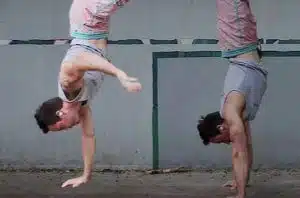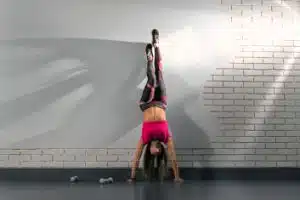Let’s face it, most of us will experience some form of back pain.
It can be disruptive, limiting our movement and reducing our sense of well-being. We want to heal lower back pain fast so we can get back to everyday life.
If You Are Experiencing Lower Back Pain You Are Not Alone
Millions of people suffer from lower back pain, and for many, the pain is chronic and debilitating.
While there are several treatments available, including medication, surgery, and physical therapy, many people find that they need to continue using some form of treatment long-term in order to manage their lower back pain.
If you are experiencing lower back pain, it is essential to seek medical help to determine the cause and find the best treatment.
One potential solution that is often overlooked is calisthenics exercises.
Calisthenics is bodyweight exercise that uses your own weight and gravity to provide resistance, which is excellent for toning and strengthening muscles.
They can also help improve flexibility and joint mobility, which are all important factors in reducing lower back pain.
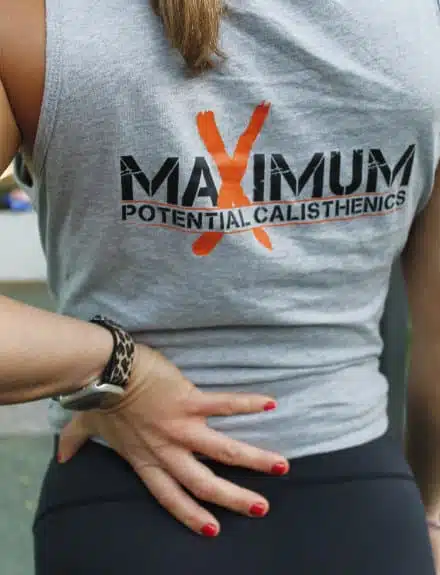
What Are The Common Causes of Lower Back Pain?
Lower back pain tends to be most common for those with minor niggles and ailments caused by incorrect posture whilst sitting at a desk for long hours, exerting yourself physically, for example, lifting heavy objects or playing a sport you haven’t played in a long time.
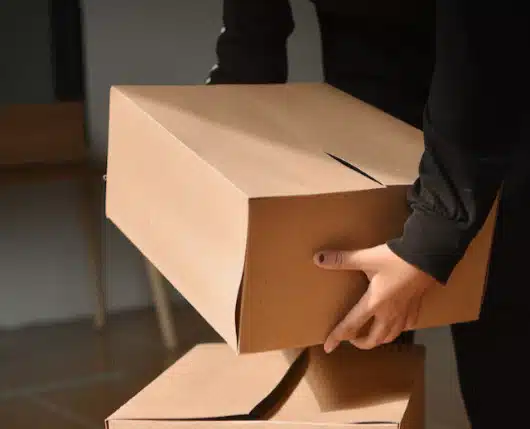
Lifting Heavy Objects Without Correct Form
One of the most common causes of lower back pain is improper lifting.
When you lift objects incorrectly, you can put a lot of strain on your lower back, leading to pain and injuries.
Overall Strength and Flexibility
A critical factor that may impact how susceptible you are to lower back pain is your general physical health.
Someone with a strong balanced body who is self-aware, will be less prone to back pain generally.
For example, when lifting an object, if the person engages their glutes (muscles in the butt) and their core before lifting and squats down if the object is on the floor (flexibility), the weight will be distributed, putting less strain on the back.
Many people simply haven’t been taught how to do this, so it’s not surprising there are injuries as a result of not engaging the correct muscles.
How many of us have been brought up to stretch every day so we can maintain our squat?
Mobility and stretching are as important as building strength and muscle activation awareness.
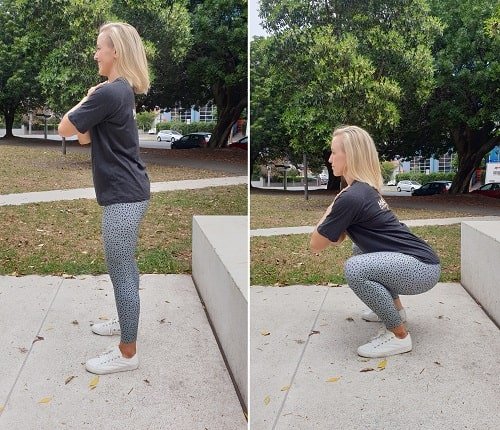
Can Exercise Help Lower Back Pain?
There is a lot of evidence to suggest that exercise can help to reduce lower back pain.
In fact, the American College of Physicians recommends that people with lower back pain try exercise before resorting to other treatments.
- Exercise, such as calisthenics, can help to strengthen the muscles in the back and improve flexibility.
- It can also help to improve posture, which can be a major cause of lower back pain.
- Additionally, exercise releases endorphins, which are natural painkillers, and it can help to improve your overall mood and energy levels.
If you are experiencing lower back pain, it is a good idea to talk to your doctor about starting an exercise program, particularly if you don’t exercise on a regular basis.
There are many different exercises that can help reduce lower back pain, such as stretching, static holds and movement reps.
These exercises can be done at home or the gym, and they can be tailored to fit your individual needs and abilities.
What Are Calisthenics Exercises And What Do They Offer For Reducing Lower Back Pain?
Calisthenics is exercises that use your own body weight as resistance.
They are a great way to improve strength, flexibility and overall fitness.
They can also help reduce lower back pain, as they strengthen the muscles in this area and help to improve posture.
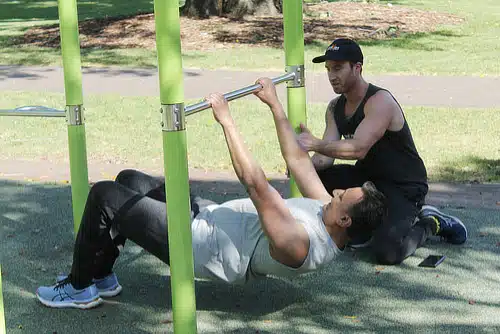
Some of the benefits of calisthenics exercises for lower back pain relief include:
- Strengthening the muscles in the back and improving flexibility
- Helping to improve posture, which can be a major cause of lower back pain
- Releasing endorphins, which are natural painkillers
- Improving overall mood and energy levels
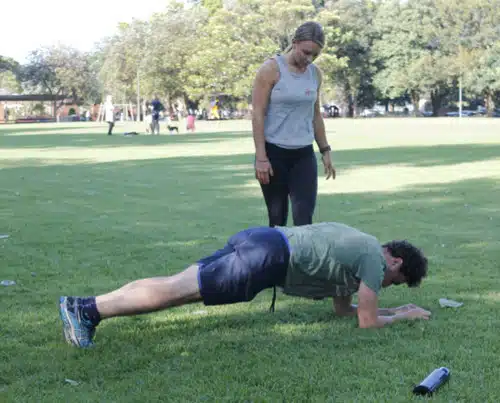
Calisthenics classes are ideal for making sure that you are following the correct form and are progressing with exercises when they get too easy.
An experienced trainer will be able to identify corrections in your form and will encourage you to increase the difficulty when it’s safe to do so.
However, calisthenics can be done in the park, at the gym, on the beach, in your back yard or even in your home.
This makes it a flexible option depending on your daily commitments; even if you are traveling you can do it in your hotel room!
How To Perform Calisthenics Exercises Correctly To Get The Most Out Of Them
When performing calisthenics exercises, it is essential to use proper form and technique to get the most out of them. Here are a few tips for how to do them correctly:
- Make sure to warm up properly before starting any exercises. This will help loosen up your muscles and prepare them for the workout.
- Start slowly and build up gradually. If you start too aggressively, you may end up injuring yourself and undoing your hard work.
- Use proper form and technique. Keep your back straight, your abdominal muscles engaged, and your movements smooth and controlled.
- Take breaks as needed. If you feel like you’re overexerting yourself, take a break until you feel recovered. Pushing yourself too hard can lead to injuries.
- If you feel any pain or discomfort in your lower back or elsewhere – stop. You should not feel any pain when performing calisthenics exercises.
A personal trainer can provide a modification or a different exercise to ensure you get a safe and beneficial workout.
When performing calisthenics exercises, be sure to focus on quality over quantity.
Take your time and make sure that you are doing the exercises correctly to avoid any injuries.
What Are Some Of The Best calisthenics Exercises For Relieving Lower Back Pain?
There are many different calisthenics exercises that can help reduce lower back pain. Some of the best exercises include:
– Glute Bridges
– Donkey Kicks
– Wall Squat
– Stretching and Mobility Exercises
Glute Bridge Raise
The benefits of doing glute bridges are that they will strengthen your glutes and train your mind to ‘switch on’ those muscles when you need to.
Lie on the floor with your knees bent, squeeze your glutes, engage your abs (stomach) and slowly raise the hips, hold at the top for a second and slowly lower. Keep the glutes and abs engaged throughout. Relax.
If you are doing multiple reps in a row, you should keep the glutes and abs engaged (no relaxation until you have completed the set).
You should NOT feel the back muscles during this exercise. If you feel any pain in the back then stop.
Here is a video of Dave, one of our coaches, performing this exercise. As you can see, he has his toes raised off the ground; this is optional, and flat feet are better for beginners.
Donkey Kicks
Donkey kicks are an excellent exercise for providing all stability and strength.
Kneel on the floor and place your hand flat in front of you. Engage your abs (stomach muscles), and slowly raise your right leg squeezing the glute.
Keeping your knee bent, kicking your leg up so that the sole of your foot is parallel to the ceiling. Hold for a second and return to the start position.
Repeat with the other leg.
Work up to 10 reps on each leg.
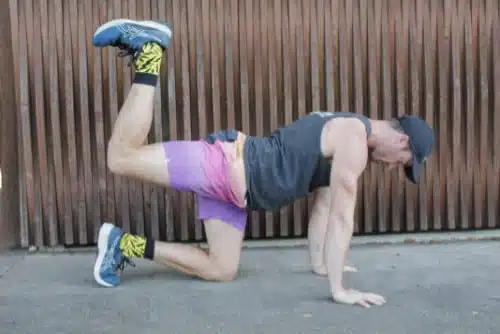
Wall Squat
Stand facing away from a wall, squat down as low as feels comfortable (ideally so the tops of your legs are parallel with the floor), leaning against the wall.
Squeeze your glutes and hold the pose for as long as you can. We’re aiming to work up to 1 minute.
When this gets too easy, you can progress to harder exercises.
However, it’s important to squeeze the legs and glutes, so don’t progress unless you do this correctly.
Lower Back Pain Stretches
Incorporate at least one mobility and stretching session per week to maintain flexibility. If you can do some stretching every day, this is ideal, start with 5 minutes to build the daily habit. Staying flexible and mobile will reduce your risk of developing lower back pain and injuries.
Cat-Cow
Start on all fours with a straight back as you breathe in; lower the head, curl the back up and tilt the pelvis under/ tuck the butt.
Hold for a second and return to the start position (exhale). Inhale as you raise the head up, looking towards the sky, and tilt your hips out.
Return to the start position. This is a great warm-up exercise for the back and a nice gentle stretch.
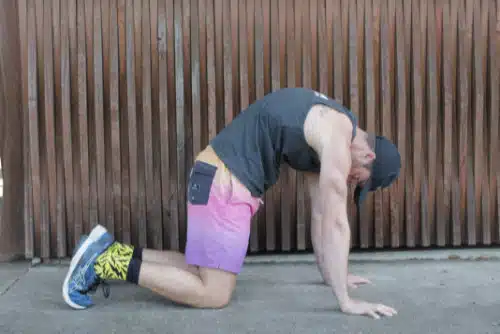
Child's Pose
Kneel on the floor, place the arms out in front and move your chest down to the floor.
Feel a gentle stretch in your back and hips. Stay here for 30 seconds to start with or for as long as feels comfortable.
For a more intense stretch in the hips, widen the knees and feet together.
Gluteal Stretch
Lie down with your knees bent and feet flat on the floor. Lift the right leg and cross the ankle over the other leg, so you feel a stretch in the right glute.
Hold on to the supporting leg and bring the knee towards the chest until you feel a good stretch. Hold the stretch for 30 seconds to start with, or for as long as feels comfortable. Repeat on the other side.
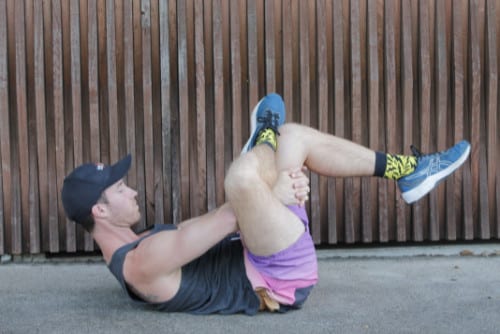
Supine Twist
Lie down on your back with knees bent and feet flat on the floor, arms extended out to the sides like a ‘T’ shape. Twist both legs (still bent) over to the left side so the left knee touches the floor (if this feels comfortable for your body).
You should feel a good stretch in the lower back. Hold for 30 seconds, then return to the start position for a few seconds and reset the spine.
Then repeat on the other side.
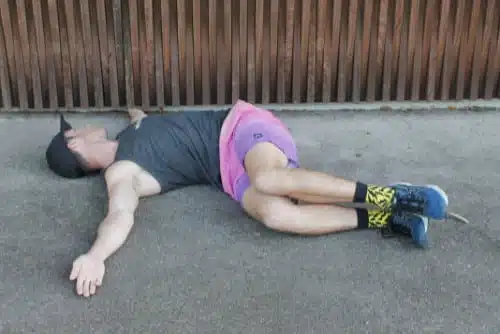
Look at our calisthenics leg post for more examples of stretching and mobility exercises.
Summary - Calisthenics For Lower Back Pain
Calisthenics and strength training programs can be helpful for reducing back pain as a result of weak muscles. Anyone starting a new exercise regime should seek advice from their health care professional to make sure it’s right for them.
When calisthenics programs are followed correctly with good form participants can make strength gains and find more ease in everyday activities.

